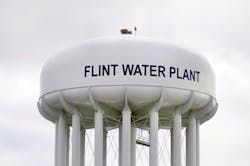A couple of years ago, Flint, Michigan, was in serious financial trouble. The water rates using water purchased from Detroit were high, and in 2014, the municipality decided to return to producing its own water. Officials hoped to reduce costs by making a temporary shift to the Flint River while laying a pipe to an intake in Lake Huron.
But they did not do it properly, and consumers were affected by very poor water quality. The change led to the introduction of very aggressive water that caused grossly contaminated water at the tap from its corrosive action on existing piping. Lead was also extracted from old lead pipe surfaces. However, indications of serious water quality problems existed well before the change. The water apparently was and might still be brown or orange and contained mobilized lead in some cases, even though the city switched back to Detroit water in October 2015.
How could something like this happen? The water supplier did not properly treat the water. The water system needed to follow the U.S. Environmental Protection Agency (EPA) Lead and Copper Rule (1991), and Michigan regulators should have enforced it because those responsibilities are delegated to the state under the national Safe Drinking Water Act. The EPA should have been more aggressive in the follow-up.
Congressional hearing
In a House Oversight Committee hearing on Feb. 3, 2016, several people testified in the Flint case. Republicans blamed the city and Democrats blamed the governor. Several members pressed the EPA to move to revise the Lead and Copper Rule as soon as possible. The EPA said that it was scheduled for 2017. Virginia Tech professor Marc Edwards and an EPA representative said that the Flint problem would not have occurred if Flint had done what was required to be in compliance with the existing Lead and Copper Rule.
Consequences
The social and economic consequences of the situation in Flint are real, but they have also been exacerbated by media hype. It was certainly a breakdown of the water supplier’s responsibilities, as well as the state regulator’s. If both parties had carried out their legal and professional responsibilities and followed regulatory requirements from the beginning, the problem would never have happened. The Flint blood lead data so far does not seem to indicate a large health impact.
State regulators did not respond rapidly to require the city to comply with the Lead and Copper Rule, and ultimately EPA’s Region 5 did not push the state regulators to do what was necessary to get Flint’s water into compliance with the regulation. It would have been a different story if all three of the authorities had just followed the law as they should have and carried out their responsibilities.
Consumers have been advised that the water is safe for showering and bathing, and all residents are still being encouraged to drink bottled water or use water filters. The EPA continues to expand its water sampling efforts in Flint.
You can find Dr. Joe Cotruvo’s full article, which appeared in the April 2016 issue of Water Technology, here.


